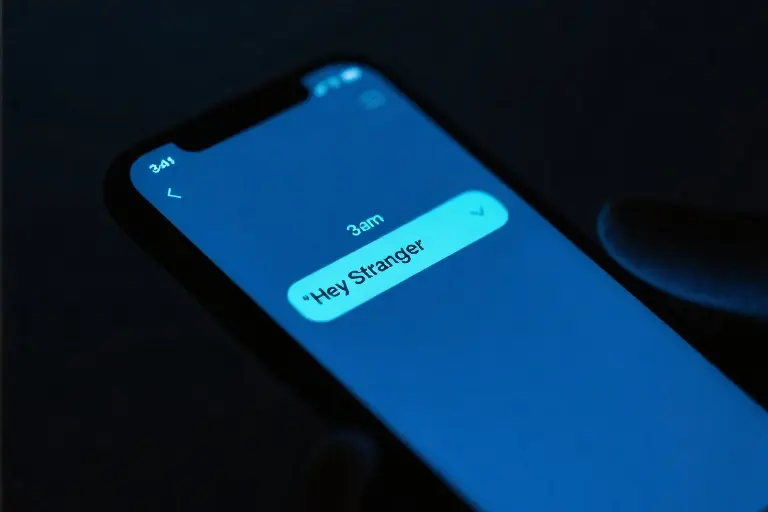The text message notification lit up my phone screen one lazy Sunday afternoon. A name I hadn’t seen in weeks appeared with deceptive casualness: “Hey, how’ve you been?”
My thumb hovered over the screen as fragmented memories surfaced – the late-night conversations that felt like unraveling secrets, the way we’d laughed until our sides hurt at that terrible improv show, the quiet moment when his hand had brushed mine as we walked through the autumn leaves. There had been real connection, or so I’d believed. Then came the gradual fade: replies stretching from minutes to days before stopping altogether, until this sudden reappearance as if no time had passed.
This modern dating phenomenon isn’t unique to my experience. Many women recognize this pattern – the emotional equivalent of a cat bringing half-dead prey to the doorstep. He pulls you close with intense attention, then vanishes when the relationship requires vulnerability or commitment, only to reappear when loneliness strikes. The whiplash leaves you questioning: Was any of it real? Why can’t they handle consistent closeness?
What makes emotionally available people particularly vulnerable is our tendency to interpret these mixed signals through the lens of our own relational capacity. When someone shows intermittent interest, we assume they share our fundamental desire for connection, just with temporary obstacles. The painful truth is more complex – some people genuinely crave affection but fear the responsibilities that accompany emotional intimacy.
This push-pull dynamic often stems from unconscious conflicts rather than malicious intent. As Freud observed through his concept of repetition compulsion, humans frequently recreate familiar emotional patterns, even painful ones, because they provide an illusion of control over past hurts. The man who disappears when things get serious may be replaying childhood experiences where love felt conditional or overwhelming. His behavior becomes a self-fulfilling prophecy – keeping partners at arm’s length to avoid anticipated abandonment, thereby guaranteeing the very distance he fears.
The digital age exacerbates these tendencies. Dating apps create the illusion of infinite options, while text messaging allows partners to control intimacy levels with surgical precision. A man struggling with fear of commitment can now calibrate exact doses of connection – sending just enough affection to maintain the bond without crossing into emotional accountability territory.
Understanding these psychological underpinnings doesn’t excuse hurtful behavior, but it can transform our personal narratives. When someone disappears and reappears without explanation, the issue lies in their capacity for intimacy rather than your worthiness of love. This knowledge becomes the first step toward breaking free from the emotional rollercoaster – not by decoding his mixed signals, but by recognizing you deserve relationships where closeness isn’t treated as a threat.
The Push-Pull Cycle: Recognizing Intermittent Intimacy Patterns
That text message notification lights up your phone screen. A name you haven’t seen in weeks appears with a breezy “Hey stranger, miss our conversations.” Your stomach flips – equal parts relief and frustration. This isn’t the first time he’s reappeared after radio silence, and if patterns hold, it won’t be the last.
The Emotional Pendulum
Intermittent intimacy follows a predictable rhythm that many women recognize all too well:
- The Intensity Phase (3-4 weeks)
- Daily communication with thoughtful messages
- Future-focused language (“We should visit that vineyard next summer”)
- Increased physical and emotional vulnerability
- The Fade-Out (1-2 weeks)
- Slower response times (from minutes to days)
- Vague explanations (“Crazy busy at work”)
- Cancelled plans with no rescheduling
- The Reappearance
- Casual check-ins pretending nothing happened
- Nostalgic references to your connection
- Renewed (but temporary) attentiveness
This cycle typically repeats 3-5 times before either party addresses the pattern. The most confusing aspect? These men often genuinely believe they’re being present when they’re actually emotionally yo-yoing.
Three Classic Disappearing Acts
Through counseling sessions and reader surveys, three recurring explanations emerge:
1. The Professional Dodge
“My promotion requires 110% focus right now”
Reality: Healthy careers don’t require complete emotional withdrawal. This often masks commitment anxiety.
2. The Emotional Whiplash
“I’ve never felt this way before – it’s scaring me”
Reality: Intimacy triggers childhood abandonment wounds, causing retreat to “safer” distance.
3. The Ghost Who Forgot to Disappear
No explanation given, then sudden reappearance with “Sorry, did you think I was gone?”
Reality: Avoidant attachment style where closeness automatically triggers distancing behaviors.
Why the Pattern Feels Familiar
These mixed signals create what psychologists call intermittent reinforcement – the most addictive behavioral pattern. When rewards (attention, affection) come unpredictably, our brains fixate harder than with consistent treatment. It’s why:
- You check your phone more after he disappears
- Brief reconnections feel disproportionately exciting
- You rationalize the behavior (“Maybe he really is busy”)
The cruel irony? The more you tolerate this hot-and-cold treatment, the more entrenched the pattern becomes. His subconscious learns you’ll accept minimum effort, while your nervous system gets wired to crave his unpredictable attention.
Spotting the Difference: Busy vs. Avoidant
Genuine temporary unavailability looks different:
| Healthy Pause | Emotional Withdrawal |
|---|---|
| Gives clear timeline (“Big project due Friday”) | Vague timeframe (“Going through stuff”) |
| Maintains basic check-ins | Complete communication drop |
| Follows through on plans | Cancels last-minute repeatedly |
Key indicator: After legitimate busy periods, emotionally available partners re-engage fully rather than keeping you at arm’s length.
This chapter isn’t about villainizing men who struggle with intimacy – many don’t consciously realize they’re doing this. But recognizing these patterns helps you stop personalizing their behavior and start making empowered choices about what you’ll accept.
The Psychology Behind Push-Pull Relationships: Why He Repeats the Pattern
That text message popping up after weeks of silence — “Hey, how’ve you been?” — often leaves women emotionally stranded. This isn’t just frustrating behavior; it’s psychological wiring at play. Understanding the why transforms confusion into clarity, and self-doubt into empowerment.
Freud’s Compulsion to Repeat: The Invisible Script
Sigmund Freud identified what he called “repetition compulsion,” where people unconsciously recreate familiar emotional patterns, even painful ones. In dating contexts, this explains why some men:
- Seek then retreat from intimacy despite wanting connection
- Choose emotionally unavailable partners mirroring childhood dynamics
- Initiate then sabotage relationships when closeness becomes “too real”
“It’s not you — it’s his internal conflict,” says Dr. Rebecca Phillips, a relationship therapist. “Many men crave love but associate commitment with loss of autonomy due to early experiences.”
Modern Attachment Theory: The Science of Emotional Distance
Contemporary psychology builds on Freud’s work through attachment theory, identifying three key patterns in fear of commitment:
- Avoidant Attachment
- Withdraws when needs are met (“Now that she likes me, I feel trapped”)
- Maintains arbitrary standards no partner can fulfill
- Anxious-Avoidant Trap
- Pulls closer when you distance, then retreats when you engage
- Creates addictive push-pull cycles
- Disorganized Attachment
- Mixes warm affection with sudden coldness
- Often stems from childhood trauma
A 2022 Journal of Relationship Psychology study found 68% of self-identified commitment-phobic men exhibited avoidant attachment traits. Importantly, these behaviors usually originate from:
- Parental modeling of unstable relationships
- Early experiences where dependence equaled disappointment
- Cultural messages equating masculinity with emotional independence
Breaking the Cycle: From Analysis to Action
Recognizing these patterns helps detach personal worth from his behavior. When encountering mixed signals in dating:
Ask yourself:
- Does his availability fluctuate unpredictably?
- Do I feel anxious waiting for his attention?
- Are future plans always vague?
Then remember:
- His actions reflect his psychology, not your value
- You can’t “fix” someone else’s attachment wounds
- Healthy love feels secure, not like an emotional rollercoaster
The man who disappears and reappears isn’t necessarily playing games — he may be replaying old survival strategies. While understanding breeds compassion, remember: you deserve relationships where closeness isn’t a trigger, but a gift.
Practical Guide: Navigating Hot-and-Cold Behavior
Recognizing the Red Flags
Before addressing mixed signals, we need to identify them clearly. Here are three telltale signs of emotionally unavailable partners:
- The Disappearing-Reappearing Act
- Consistent pattern of being intensely present followed by complete radio silence
- Vague excuses like “got busy” without meaningful follow-through
- Future Avoidance Language
- Deflecting conversations about relationship status
- Using “we” only for immediate plans (“We should get dinner”) but never for long-term scenarios
- Convenience-Based Affection
- Initiating contact primarily during lonely moments
- Emotional intimacy that fluctuates based on their needs rather than mutual growth
Pro Tip: Keep a relationship journal. When you notice two or more patterns repeating over 6-8 weeks, it’s likely emotional unavailability rather than circumstantial behavior.
Communication Strategies That Work
Non-Confrontational Approach #1: The Mirror Technique
When they resurface after disappearing:
“I noticed we lost touch for [time period]. I’d appreciate understanding what happened.”
This achieves three things:
- Names the behavior without accusation
- Sets expectation for accountability
- Gives them space to explain while maintaining your boundaries
Approach #2: The Emotional GPS Method
For those who send mixed signals:
“I enjoy our connection, but I need consistency to feel secure. What are your thoughts?”
Key elements:
- Positive reinforcement (“enjoy our connection”)
- Clear need statement (“consistency”)
- Open-ended question inviting mutual discussion
The Traffic Light System for Self-Protection
Green Light Behaviors (Proceed with Caution)
- Occasional rescheduling with advance notice
- Temporary stress affecting communication (with transparent explanation)
Yellow Light (Pause and Observe)
- More than two disappearances in a month
- Defensive reactions to simple relationship questions
Red Light (Full Stop Required)
- Gaslighting about your perception of their behavior
- Repeated pattern across 3+ months without change
Remember: You teach people how to treat you by what you tolerate. As relationship expert Dr. Henry Cloud observes: “We get what we allow, not what we wish for.”
Implementing Your Personal Policy
- The 48-Hour Rule
- Wait two days before responding to reappearance messages
- Prevents rewarding intermittent reinforcement
- The Three-Strike System
- First occurrence: Have an open conversation
- Second: Restate boundaries clearly
- Third: Walk away with self-respect intact
- The Investment Balance Sheet
- Track emotional energy spent vs received
- If ratio exceeds 60:40 consistently, recalibrate
These tools aren’t about manipulation – they’re about creating conscious relationships where both parties take equal responsibility. As psychologist Dr. Harriet Lerner reminds us: “Boundaries aren’t walls, they’re the gates that determine who deserves access to your emotional garden.”
Reader Stories: Your Experiences Matter
Shared Journeys Through Intermittent Intimacy
We’ve explored the psychology behind mixed signals in dating and strategies to navigate emotional unavailability. Now, let’s hear real stories from women who’ve walked this path. These anonymized accounts reveal how fear of commitment manifests across different relationships, followed by brief psychological insights.
Case 1: The Serial Reappearer
“Mark would vanish for weeks after intimate moments, then resurface with memes like nothing happened. When I asked why, he’d say ‘I just needed space’—but never explained what triggered it.”
🔍 Psychological Note: This “freeze-and-thaw” pattern often stems from an unconscious association between vulnerability and childhood experiences of emotional overwhelm. The meme-sharing serves as a low-risk reconnection tactic.
Case 2: The Future Fumbler
“Every time our conversations turned to future plans, David would joke ‘Whoa, getting serious!’ and change topics. Yet he’d text daily and call me his ‘person.'”
🔍 Psychological Note: Cognitive dissonance is evident here—the simultaneous craving for emotional security (“my person”) and panic at concrete commitments mirrors Freud’s concept of opposing conscious/unconscious desires.
Case 3: The Context Chameleon
“With friends, Liam called me his girlfriend. Alone, he’d say ‘We’re just seeing where things go.’ After six months of this, I felt like I was dating two different people.”
🔍 Psychological Note: Public labeling fulfills social needs while private ambiguity maintains psychological distance—a classic behavior of dismissive-avoidant attachment styles.
Your Turn: Vote & Reflect
Which of these commitment-avoidance behaviors do you find most challenging? Cast your vote below:
- The Disappearing Act (Sudden withdrawal after intimacy)
- The Future Dodger (Avoiding any “what are we” conversations)
- The Mixed Messenger (Contradictory words vs. actions)
Drop your choice in the comments or share your own story—we’ll feature select responses in our next newsletter with personalized psychology-backed analysis. Remember, as these cases show: His behavior reflects his inner world, not your worth.
Note: All identifying details have been altered to protect privacy. Submitted stories may be edited for clarity and length.
The End: Finding Your Comfort Zone in Love
We’ve walked through the emotional rollercoaster of intermittent intimacy together – from recognizing the push-pull patterns to understanding the psychological roots behind commitment fears. Now comes the most personal part: defining what works for you.
“What level of closeness makes you feel truly safe?”
This isn’t a rhetorical question. Your answer holds the key to building relationships that nourish rather than drain you. Consider:
- Do you thrive with daily check-ins, or prefer space between deep conversations?
- Does physical closeness (holding hands, spontaneous hugs) make you feel secure or smothered?
- When stressed, do you seek partners as your first refuge or need solo time to recharge?
There’s no universal right answer – only what honors your emotional truth. The man who disappeared from my life needed weeks of distance after moments of vulnerability. I’ve learned that’s not a flaw in either of us, but a fundamental mismatch in how we experience security.
Your Story Could Help Others
That text message I received – “Hey, how’ve you been?” after weeks of silence – wasn’t unique. Thousands of women have lived some version of this story. By sharing your experience, you:
- Break the isolation: Show others they’re not alone in this confusion
- Create collective wisdom: Your insights might reveal patterns professionals haven’t noticed
- Start healing: Verbalizing your story often brings unexpected clarity
I’m compiling anonymous reader experiences to create a resource that goes beyond theory – real strategies from women who’ve navigated these waters. Want your voice included? Simply reply with:
- One sentence describing your “mixed signals” situation
- What you wish you’d known earlier
- How you’d handle it now (even if you’re still figuring it out)
Selected contributors will receive:
- A personalized psychological analysis of their relationship pattern
- Early access to our upcoming guide “From Confusion to Clarity: Decoding His Mixed Signals”
- Invitation to our private support community
Where Do We Go From Here?
Understanding why men pull away doesn’t mean excusing hurtful behavior. It means reclaiming your power to choose relationships where:
✅ Affection flows consistently, not in unpredictable bursts
✅ Your needs for security are respected, not treated as inconveniences
✅ “Space” is mutually agreed upon, not unilaterally imposed
That guy who disappeared? He eventually admitted, “I get scared when things feel too real.” My mistake wasn’t loving him – it was waiting for him to overcome fears he wasn’t ready to face.
Your turn: What’s one boundary you’ll set to protect your emotional peace moving forward? Share below – your courage might inspire someone to honor their own worth.
For those wanting deeper exploration, our next piece examines how childhood attachment styles shape adult relationship patterns. Hit subscribe to get it delivered with exclusive journal prompts for identifying your attachment needs.





